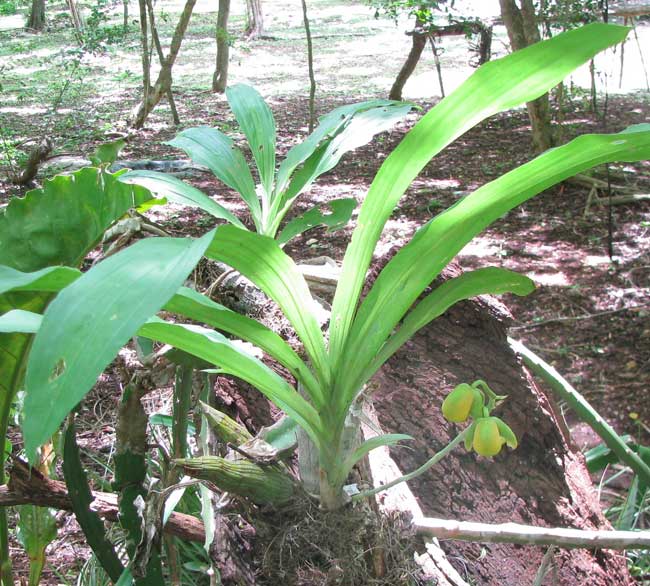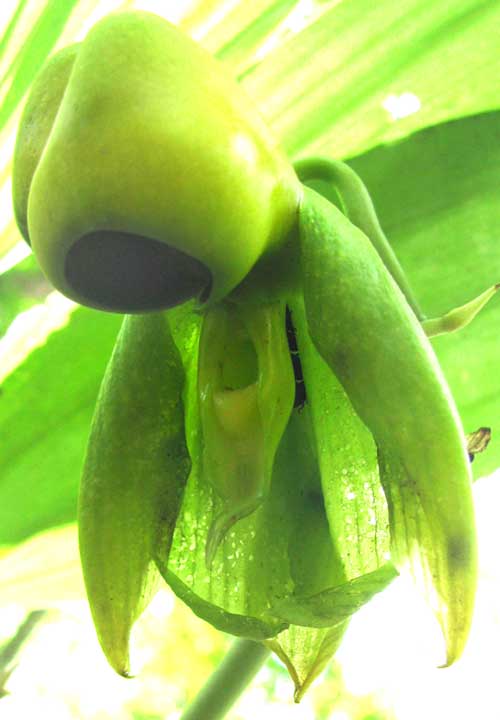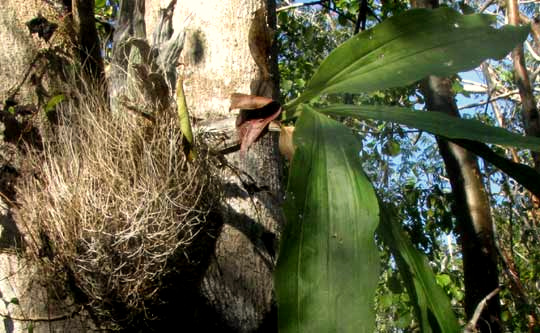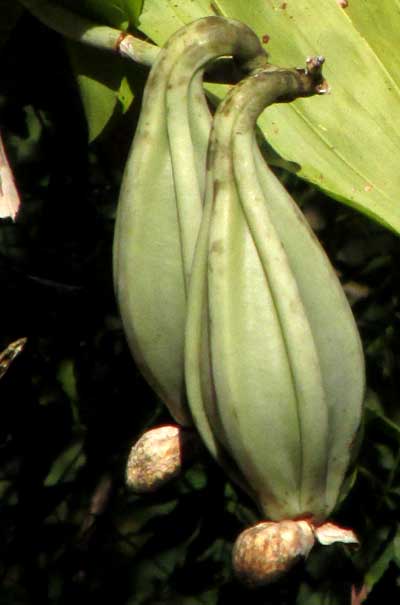Excerpts from Jim Conrad's
Naturalist Newsletter

from the July 25, 2010 Newsletter issued from Hacienda Chichen Resort beside Chichén Itzá Ruins, central Yucatán, MÉXICO; limestone bedrock, elevation ~39m (~128ft), ~N20.676°, ~W88.569°
CATASETUM ORCHID FLOWERING
With the rainy season well underway now the Catasetum orchids are flowering, as seen at the bottom, right of the log-perching orchid shown above.
Before getting to the flowers, notice that at the lower left in that picture there arise from the plant's base two elliptical, pointy, green objects. Those are pseudobulbs, which only some orchid genera produce. Pseudobulbs are modified stem sections that store water during the dry season. During the dry season our Catasetum orchids lose their long, flat blades but the pseudobulbs survive. In our picture you can see how the new plant and its flowering head have sprouted from the pseudobulbs' bases, not from atop an older pseudobulb. Well watered plants in gardens may not lose their pseudobulb-top leaves.
Catasetum's flowers are mysterious-looking, like a praying monk's yellow-green cape and hood, as shown below:

If you're familiar with orchid flower structure but can't figure out what you're seeing there, the blossom makes more sense when you learn that the "lip," which in most orchid flowers with lips hangs below forming a cuplike affair, in the genus Catasetum is held above. The monk's "hood" in the picture is the lip. The thing dangling from the monk's neck like a broad tie equipped with a birdnest is the "column," a special feature of orchids consisting of fused stamens, style and stigma.
Catasetum orchids bear separate male and female flowers with occasional intermediate or hermaphroditic forms. Female flowers are said to be very similar from one species to another, but the male flowers may differ markedly. I'm looking for male flowers.

from the March 7, 2010 Newsletter issued from Hacienda Chichen Resort beside Chichén Itzá Ruins, central Yucatán, MÉXICO; limestone bedrock, elevation ~39m (~128ft), ~N20.676°, ~W88.569°
A BIG-FRUITED ORCHID
Nowadays it's not unusual to see what's shown above. That's an orchid growing about 20 feet up on a big branch of a Piich tree (Enterlobium cyclocarpum), which now in the dry season is almost leafless, inviting brilliant sunlight to illuminate the orchid's unusually large (for an orchid), broad, several-veined leaves. This particular orchid is bearing an uncommonly large, several-veined, fruit on its sagging, 16-inch (40 cm) peduncle. Though many such orchids occupy larger trees here, few bear such fruits.
In a land with no field guides to help identify the orchids and no identification keys available to the general public, how do you get the name for something like this?
I knew the plant family it belongs to -- the Orchid Family -- so I went to "The Flora of Quintana Roo" (Quintana Roo being the state just east of us), and found 24 species listed there in the Orchid Family. Then I set using the Google Image Search Engine, searching on each species name.
By comparing pictures found there I'm fairly sure that our orchid is CATASETUM INTEGERRIMUM, described as occurring from Mexico to Nicaragua, and as growing in humid forests, coffee plantations and open country. I find no English name for it.
adapted from the January 15, 2012 Newsletter issued from Hacienda Chichen Resort beside Chichén Itzá Ruins; limestone bedrock; elevation ~39m (~128ft), N20.675°, W88.569°; central Yucatán state, MÉXICO
WHITE ROOTS ON EPIPHYTIC ORCHIDS
Maybe you've noticed that epiphytic orchids -- those growing on trees -- produce very thick, white roots. Those white roots help distinguish orchids from other epiphytic plant types, such as bromeliads. You can see such roots on a Catasetum integerrimum below:

Why are they so thick and white?
At first I imagined that the white covering was composed of mycorrhiza. Mycorrhizae are fungi living symbiotically on and in plant roots. They improve a root's carbohydrate storage capacity, help the roots absorb more mineral nutrients and transport water, and other things. However, there are two kinds of mycorrhiza: ectomycorrhizae, which form an exterior sheath on roots, and; endomycorrhizae, which live deep inside the roots. And I read that orchids have endomycorrhizae. Our orchid's white root covering is not an ectomycorrhiza.
Finally it occurred to me that often these white roots are seen dangling freely in the air or even standing up as somehow rooting in the air, as shown above. Googling the topic of orchid absorption of water from the air, eventually I learned that the white, spongy, water-absorbing material covering epiphytic orchid roots (sometimes it can be silvery or brownish) is called "velamen." Anatomically velamen can be thought of as a root's much modified, spongy epidermis. Its main purpose is to wick water from the air, but also it serves as insulation for the roots. Velamen has a layer of thick-walled cells that keeps water from escaping as well as occasional thin-walled cells that allow water from outside to pass toward the root's conducting tissue.
Velamen-covered roots can function as ordinary roots, too, developing root hairs and absorbing nutrients from the host-tree bark it touches. The nutrients it absorbs on the orchid's arboreal perches derive from dead tree-bark, dissolved dust particles, bird droppings and the like.
from the December 21, 2018 Newsletter issued from Rancho Regensis north of Valladolid, Yucatán, MÉXICO;
elevation ~40m (~130 ft), N~20.876°, W~88.170°
CATASETUM ORCHID FRUIT'S STRANGE APPENDAGES
Only this week have I been able to take a good look at this orchid's fruit pods, and I see that something peculiar and regularly occurring is going on there. Below, you can see two fruits on an orchid near the hut, both with those odd appendages at the bottom:

W.J. Hayden at his fine Flora of Kaxil-kiuic website says that the dark items are dried-out remains of the flower's sepals and petals, and now that I know that, I can see it. In the above picture, the large, scoop-shaped thing is the "monk's hood."
How would such appendages be of service to the orchid? I'm guessing that they help in seed dissemination. Later the capsules will split, and maybe those bottom parts will catch wind and shake seeds loose from its capsule, or maybe the parts will attract an animal's attention, who then will shake the fruit, sending seeds flying.
Whenever anything out of the ordinary like this comes along in Nature, it's always fun to try to figure out why the evolutionary process has made things as they are. Sometimes you get it right, and sometimes you overlook the obvious, or simply get it all wrong.